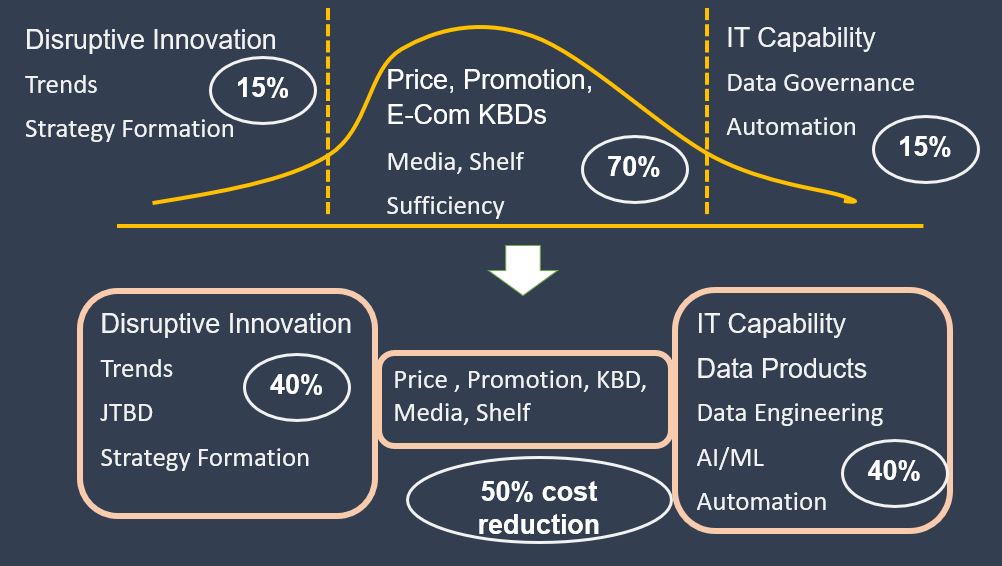Taking out my crystal ball….What will significantly increase, what will stay the same, what will decline? How will these be acted upon? My predictions…let me know your perspective, I can be wrong at times.
1. More platforms, fewer one-off projects.
The quality and productivity transformation behind “the platform” for Concept and Copy testing is just at the forefront of the 40+ research methods. Package testing, Claims, and Brand Health Tracking are immediately next. The DiY survey industry is moving into more vertical solutions, with panel presets, standardized best-in-class surveys that allow for longitudinal analytics, AI models, visualization and data products to feed downstream composite applications, or specialized data hubs.
The “here is a bag of legos, build your own” will move to “here is a performance, finely tuned machine for package testing, integrated with your assets repository, and your data lake”. With two-way integration to maintain the high quality of metadata, and respondent-level feed back into the internal data products.
Over time, these data products will be the ingredients for more sophisticated AI models, and further velocity on productivity improvement and costs.
2. More AI injected in the research pipeline, less stand-alone AI.
The era of “download your survey”/”upload into our AI tool” creates too much friction in the research pipeline. We will see the emergence of AI as a Service (AIasS) API calls. Summarization, sentiment, and keyword extraction will be the first models needed. Models will be category-specific and have pay-per-call pricing.
There will be an emergent field of AI Model Cards that will describe the bias, the limitations, the accuracy and precision (F1 score), and the edge cases for the AI models. The F1 scores will need to be visible in the downstream applications, and the nice visual in dashboard will have a paired F1 score that shows the credibility of that data based on the F1.
3. More data products, and fewer PowerPoint research summaries.
The era of 100-slide PowerPoint will move into the era of respondent-level data ingested via APIs, and the creation of Data Products aligned to research methodology (concept, copy, claims, package).
4. More qual, less quant.
Video qual at scale, VR and AR, direct consumption observations, in-home visits, and shop-along, powered by productivity brought by AI cognitive services (summarization, sentiment analysis, keywords, annotations) provide deeper insights than surveys.
5. More First Party data, less programmatic panel.
Investing in first-party data is a big commitment, but the value of deep insights, longitudinal research, and path to purchase visibility will make the difference between a chart, and unexpected truth that can be acted upon.

6. More JSON, less SQL.
The future of Consumer insights is unstructured data. If your data strategy is still based on tabular, SQL DB, and has no DynamoDB, MongoDB, or Cosmos DB in your data diagrams, you are building for the past. APIs and AI speak JSON.
7. More ethnography, fewer survey charts.
The skillset in Insights will take the shape of a barbell, with one side of AI, Data engineering and Automation. The other distinct side will be on deep insights, with anthropology and anthography skills for the JTBD identification.
8. More storytelling, fewer charts, and tables.
We, humans, love a good story. Great charts and data will need a theme, a villain, a mentor, and a hero’s journey. Joseph Campbell will make a comeback, and the great storytellers will sit at the strategy table.
9. More deep insights and IT work, less pricing/ promotions/media optimization.
The workload in Consumer Insights will be hollow in the middle, where the majority of work is the optimization of the big levers. Data products, AI, and bots will take over a large portion of that work.

10. More generative analytics, and fewer predetermined dashboards.
The generative text and generative code we see in GPT-3 is just the beginning. Dashboards will move to a generative, chatbot-driven real-time visualization of data, with key insights served on the side.
A “General Manager” summary notebook will become affordable to produce at scale for all optimizers in the middle. AI, Data products and generative analytics will further hollow the middle, where most of the work happens today in Consumer insights.
11. More AI, Data, and Strategy skills, less research methodology stats skills.
The “hollowing of the middle” will allow Consumer Insights professionals to bring more to the strategy formation discussions, with trends, concepts, and deep insights to grow/transform their category. Some will see this as “back to the table”, for the long-established Consumer Insights departments. For others, this will be a completely new role, with a new set of skills needed.
Leave a Reply